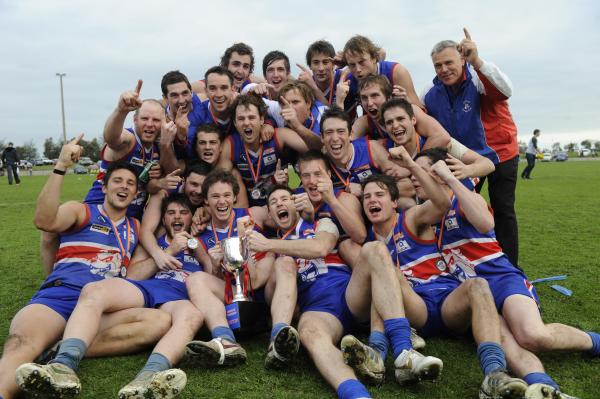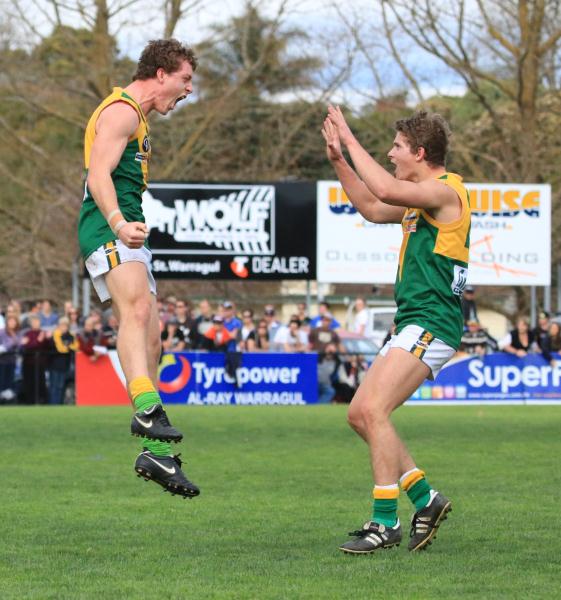
By Russell Bennett

The closer some clubs are, the stronger their rivalry is.
That’s definitely the case of the Garfield Football Club’s shared history with Bunyip over the decades.
Essentially, the same people from the same community sit on either side of this divide.
But that’s just the thing – it’s hardly a serious divide. It’s more of a familial rivalry, where one brother will move heaven and earth to one-up the other – but when it’s all said and done, the respect and the mateship shines through most.
Nothing typifies that more than in the aftermath of both the 2012 and 2013 Ellinbank and District Football League grand finals.
In 2012, the Bulldogs claimed a famous victory over the Stars at Garfield in scenes that haven’t come close to being replicated since.
The sheer number of people who flocked to watch the two sides go head-to-head in the decider at Beswick Street almost had to be seen to be believed.
All told, about 12,000 people converged on the ground from all corners – from beyond Gippsland – to watch this historic battle be reignited under sunny skies.
After all, it was the first grand final between the two sides in more than 70 years.
The fires of the rivalry were really stoked way back in 1939 – in extraordinary circumstances for that year’s grand final.
As the legend goes, the Garfield side refused to play on a sodden Nar Nar Goon ground and the premiership was handed to Bunyip by forfeit after they took to the field and captain Wal Toy kicked the only goal of the game.
Two Garfield players made it to the ground that day, Jack Smith and Jack Miller, but were told by the umpires that if they took the field, they’d have to play against the entire Bunyip side. So, they watched helplessly as a single goal decided the flag.
Smith was serving in the RAAF in Laverton at the time, traveling back to Garfield on the weekends to play footy.
With the onset of World War II, he found it harder and harder to get time off to go back and play.
In 2003, he spoke about that period of time to Gazette reporter Matt Cunningham – the son of Garfield’s president in 2012 and 2013, Gerry Cunningham.
“I plucked up the courage to ask my commanding officer, explaining that it was grand final day and I wanted to play,” Smith recalled.
“He replied ‘Lad, there is a war on. In my office. Get back to your job!’.”
But Smith’s commanding officer ultimately relented, and he packed his footy gear and set off to Garfield – with the help of two officers he paid for a lift.
After all of that though, when he arrived at the Goon, Miller was the only one there to greet him.
Bunyip icon Clarrie Steenholdt was 98 when he passed away in April last year.
As a young wingman, he was brought in as the 19th man for the 1939 decider.
In the days leading up to the 2012 grand final at Beswick Street, he spoke to the Gazette about the famous rivalry between the Yips and the Stars.
“I was working out at Labertouche and got the message through the milk carter that I was required to come down and play,” said Clarrie, just outside the Bunyip clubrooms in 2012.
He had a motorbike and sidecar as a teenager, and had to pick up two of the Bulldogs’ best players – Don Laurie and Percy Wade – on the way to the game because they had no other way of getting to the ground. One hopped in the sidecar, and the other on the back.
The 1939 decider, itself, was a game that stopped two towns – just a couple of kilometres apart – in their tracks. The rivalry was thicker than Collingwood and Carlton at its most fierce.
Yet Clarrie said the controversy didn’t affect the friendships between the players on either side – it just strained relations between the opposition teams.
Six years later, in 1945, he was part of the Bunyip premiership side.
In 2012, those extraordinary scenes some 73 years prior were deemed officially dead and buried, and – fittingly – the Stars and Yips celebrated Mad Monday, together as one. They would go on to do the same a year later, after they faced off once more in the grand final – that time at Warragul’s Western Park.
While Bunyip won in 2012, the Stars turned the tables the following year.
The Garfield banner for the 2012 clash read “It’s not 1939, the ‘Stars’ are all here this time! Go Stars”, but Bunyip historian and club icon Leigh Greening declared the events of ’39 dead and buried before the opening bounce of the first EDFL decider between the two clubs.
Sharing a beer with Garfield icon ‘Possum’ Miller in the Garfield Hotel before the game, Greening declared: “The events of ’39 are behind us – the boys from both teams will create a new history today”.
While the official word surrounding the 1939 decider was that Garfield objected to the state of the ground, there have long been rumours that there was a significant wager placed on the result and, having a side that wasn’t conducive to wet weather footy, the Stars didn’t turn up for fear of having to pay out.
But Steenholdt was holding his cards close to his chest in 2012, telling the Gazette: “I know what happened, but I will never say”.
By the back-to-back grand finals in 2012 and ’13, the events of the past were consigned to just that – pages of the clubs’ history.
In the new era, just as had always been the case, two bands of great off-field mates relished the chance to resume on-field hostilities.
But off the field after each game, the mutual respect continued to grow with each beer poured.
Leigh Greening – Bunyip icon and club historian
He’ll never shy away from it. For someone with red, white and blue flowing through his veins, Bunyip’s 2012 premiership on enemy soil was the best day of Leigh Greening’s life so far – outside of his wedding day, and the birth of his kids of course.
“The real Bunyip/Garfield rivalry definitely started from that controversial grand final in ’39,” he explained.
“Without a doubt.
“There were some Garfield people long after that who wouldn’t even go into the town of Bunyip, and the two towns are right next door to each other.”
As the years have worn on, the hostility – particularly off the field – has subsided.
But for Greening, one, famous individual battle within the wider Bunyip and Garfield rivalry shines through.
“Brian Cash used to coach Garfield and he was an outstanding footballer – Cashy was a two-time Clancy Medal (which became the Breheny Medal) winner and also a barrister. He and Clark Saunders – who played at Bunyip and was a fantastic, tough player in his own right – used to go hammer and tong against each other like you wouldn’t believe,” Greening explained.
“Stan Young is a great mate of mine, but he’d only be a novice (in on-field physicality) when it came to these two blokes!
“On the ground, no one would dare step in between them.
“But, no bullshit, these two blokes finished up the best of mates for a hell of a lot of years after their footy days had finished.”
Some of the biggest footballing names in the region have featured heavily in this rivalry over the years – names such as Papley, Marsh, Barnes, Payne, Miller, Breheny, Roberts and Cleary – but a chain of events in 1981 could have seen the two clubs move forward as one.
It seems incredible these days, but the VCFL – in conjunction with the WGFL – proposed that the Garfield and Bunyip football clubs merge.Just as the Melbourne and Hawthorn faithful railed against the ‘Melbourne Hawks’ proposal of 1996, the favourite sons and daughters of Bunyip and Garfield weren’t going to stand for it.
“In ’81, the two clubs were told to amalgamate,” Greening recalled.
“There was meeting after meeting in the old Garfield hall about it, and all their famous families were dead against it, just as we were.
“But in the early ‘80s, Bunyip was seriously at rock-bottom. The club still had the town behind it, and it still had its juniors, so our main point was that we couldn’t just let the club die.”
In recent decades, both clubs have had their share of premiership success throughout the grades and both remain strong, committed community clubs.
In 1981, both clubs appealed the proposed merger and that took them all the way into VFL House.
Former Hawthorn chief executive John Lauritz headed up the VCFL at that point.
“We fronted up to VFL House this one Friday afternoon,” said Greening, who was Bunyip’s delegate for the appearance. Laurie Marsh was the Garfield delegate, and Bob Utber was the WGFL delegate.
“After they heard all the evidence, everyone left the room and came back in and Lauritz said ‘as of this minute, the Bunyip Football Club is now affiliated with the Ellinbank and District Football League, and Garfield is to stay as it is in West Gippsland’.”
Club people from both sides were rapt with the outcome.
“We all went back to the Garfield pub that night and everyone else from the two clubs was waiting on the news – this was before mobile phones, of course,” Greening said.
“Everyone was thrilled, and we all had a few beers to celebrate.
“The joy on the faces of the Garfield faithful I remember vividly. They were names including Tim Payne, Jimmy Fawkner, Tommy Miller, and David Schmutter.
“Both clubs went on to do their own thing, and have had success since.”
While some within the EDFL weren’t thrilled with Bunyip moving into the competition, they ultimately had no real choice – given the call was made by the VCFL panel.
Bunyip and Garfield then didn’t play each other again until 2010, when the Stars joined the EDFL. They then beat Neerim-Neerim South in the 2011 decider, before the back-to-back Bunyip and Garfield grand finals at Garfield and Warragul.
Greening’s lasting thought on the rivalry is a simple one.
“As much as it riles Bushy Miller, Bunyip is still one premiership ahead of Garfield!” Greening said.
“While the communities are as they are, Bunyip and Garfield must continue to play each other every year – it’s that simple.
“No matter where we go, we can’t be without Garfield, and vice-versa.
“We’ve always considered Garfield as our arch rival but, by God, the best of mates off the field.”
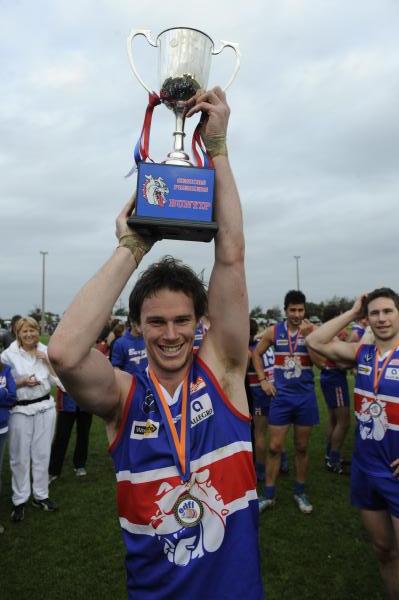
Brad Walker – 2012 Bunyip premiership-winning skipper, current president and senior player
Bunyip’s president is still an integral part of its senior side, but perhaps the defining chapter of his playing career was written in 2012 as he held the cup aloft with then playing-coach Cal Pattie, and president Darrell Wilkinson.
That image couldn’t have been further removed from a freak on-field accident in 2006 that left him with a broken neck and within milimetres of having his football dream, even his life, taken from him.
The incident that happened in an early-season game against Nar Nar Goon led to him missing two straight years of footy.
But it was much bigger than just the game.
“I was basically just picking the ball up off the ground in the middle,” he recalled to the Gazette, sitting on a massage table straight after the 2012 decider, with a premiership medal draped around his neck.
“I’ve gone to try and burrow my way through and a guy’s quad has come through and hit me on the top of the head.
“Because I had my head over the ball, I was thrown backwards and I landed on my back.
“I went numb down my left side, which I later found out was part of my vertebrae going into my spinal cord.”
Incredibly, the tough-as-nails Walker even returned to the field that day in ’06. It was only when he started experiencing blurred vision that he knew something was desperately wrong. He ultimately spent a month in the Alfred after the clash.
The scenes immediately following the 2012 grand final meant the world to the Bunyip faithful, and in a way, even more to Walker.
“The league and clubs around us probably thought we over-achieved that season, but we really rated our list,” he told the Gazette on the weekend.
“I really think our unity as a group helped us achieve what we did. In that year, we would have won four or five games by under two goals.”
And a big part of that reason was the way Bunyip was led. Garfield, fittingly, was so similar.
“As an on-field leader, there weren’t many better than Cal Pattie – and Garfield had Easty (Brent Eastwell), who was much the same,” Walker said.
“They’re two of the biggest warriors in terms of being able to take a game by the horns.
“They’re always there in the game-changing moments.
“Both of them came from outside the local community – they weren’t Garfield or Bunyip born and bred – but both would be able to walk into either club these days and be embraced by everyone. They’re one of us, for sure.”
And at the other end of the spectrum were the young guns rising through the ranks to make their own mark in 2012 and 2013.
There were none more influential than Eddie Morris – currently regarded as the best player in the Gippsland League – and Sydney Swans star Tom Papley.
“I don’t know how many more successful young players we’ve had come out of our neck of the woods in recent years,” Walker said.
“Eddie is a team of the decade player at Casey and the number one ranked player in Gippsland at the moment – he basically won the game for them in that 2013 grand final, along with Andy Soumilas.
“And then we’ve got our own Tommy Papley, who was probably only about 5’0” tall at that point and 50 kilos ringing wet.
“What he did in that final quarter in 2012 is something you expect someone with 200 games’ experience to be able to pull off. He was 16, and just amazing.”
At the other end of the experience spectrum at that time, Garfield’s Andy Soumilas is one Walker highlighted as a particularly challenging opponent.
“I was lucky enough to play one year with him at Drouin,” he said.
“With the way he reads the game, he’d be the best player I’ve played with or against over my career.
“He’s smarter than anyone else out there, and his footskills and brute strength make him just about an unstoppable player.
“He reads the ball so well, gets opponents out of position so well to give himself time, and he can’t kick over a jam tin, but every one of his kicks finds its target.
“Even in the past few years at Inverloch he’s won another league medal. At his age, to be able to do that in a competition as strong as the WGFNC, it just goes to show how much of a talent he really is.
“He was injured in 2013 but it wasn’t too far into the game before he started doing what he does best, and he made a massive difference for them that day.”
Walker also spoke about the build-up to, firstly, that 2012 clash.
“Before the game, the silence was nearly deafening,” he said.
“The nerves were just so high within the rooms, but it was more of a steely determination. We were ready for the battle, and we knew it was going to take every part of us to be able to break Garfield.
“Along with Cora Lynn, they had a fantastic side that year and it was going to take our best footy to beat them.
“We just held on, and through that last piece of the battle we willed ourselves through to be able to win it.
“Much like it was for Leighroy (Greening), it’s a day I’ll never forget, and one of the best days of my life – undoubtedly – particularly given (wife) Sam was able to win the A Grade flag for Ellinbank as well.
“Coming back from what I had, to be able to captain that side in 2012, it was just an unbelievable feeling and something I don’t think I’ll ever be able to replicate throughout my sporting career.”
Walker and former Garfield champion ruckman Tom Marsh grew up together as close childhood mates, and they always had fierce Bunyip versus Garfield debates.
“Your best mates are generally always, somehow, Garfield people so you end up having this discussion around which is the better club and who’s the better player, and even coaching the under-18s a couple of years ago I know the feeling is still there.”
For years there, neither club knew who had the ascendency over the other – but they got the chance to find out when Garfield made its own switch into the Ellinbank league for 2010 onwards.
“From then on, it’s been the one game you can’t afford to lose all season,” Walker said.
“Regardless of where you are on the ladder, it outweighs all other home and away games.”
But after those matches, the mateships would come straight back to the fore – almost immediately.
The sides’ shared Mad Mondays of 2012 and 2013 are proof of that.
“We’ve just got such a genuine respect for each other, and we’re very close with one another, but that also means they’re the fiercest games I’ve been involved in,” Walker said.
“We were actually very nervous heading into the Garfield pub for Mad Monday in 2012 – we didn’t quite know what to expect – but within about five minutes we were having competitions against each other.
“From a league perspective I think it’s fantastic you had clubs not just isolating themselves on the Mad Monday and celebrating or commiserating, but going to catch up with their mates from within the league.
“And after games you can’t go into either club’s rooms and not bump into 10 people you want to have a conversation with.”
In his current role as Bunyip president, Walker has even approached Garfield with the idea of creating a shield named after one of the most famous names to have played for both clubs – Bunyip icon, and dual Breheny medallist and premiership player at Garfield, Tom Cleary.
“I think the game, itself, creates so much of a buzz around the two towns that I definitely think it’d be really special to play for an annual shield,” he said.
“It couldn’t be more fitting than to name it after Tom Cleary, who’s been a superstar at both clubs and is a great bloke on and off the field.
“His is the first name that springs to mind when I think of Bunyip versus Garfield, and if the two clubs could play for something named after him, I think it’d be truly special.”
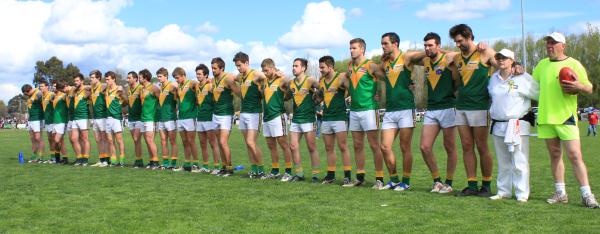
John ‘Barrel’ Barnes – Garfield icon, multiple senior premiership winner
Not only has he left an indelible mark on the history of his beloved Stars, John Barnes knows the Garfield versus Bunyip battle better than anyone – and just where it stems from.
“Not only was it through school, but it was also through sports outside of footy as well,” he said.
“You’d play against the same people all the time – and sometimes with them too.
“We were all mates – we’d all hang around together, and that’s why it was such an entertaining rivalry.
“Being beaten by Bunyip was just the worst because for the next 10 weeks until you played them again, you couldn’t get back at them.”
Barnes, too, knows the real genesis of the rivalry stems back to the 1930s.
“The recollections of that grand final in 1939 are different depending on which side you speak to, but ever since then to be beaten by Bunyip is just the worst thing that could happen in your sporting life as a Garfield person – whether it was in footy, cricket, whatever.
“It was all about the bragging rights, and holding them was just the best thing.”
Barnes and Greening are not only great mates, they’ve also played golf together consistently over the years – and one constant topic of conversation has been those 2012 and 2013 grand finals.
“The scenes at the Garfield pub after the game in 2012 were just extraordinary – seriously incredible,” Barnes said.
“In 2013, the beauty was that we could beat them after suffering through 12 months of gloating and carrying on! It was just a pity we couldn’t say we did it at their ground, like they did to us.
“Leighroy could have died that day in 2012 a happy man – it made his life, and made ours from Garfield miserable!
“In all seriousness though, there’s a massive respect there – there’s no doubt about it.
“There are a lot of players over the years that have gone back and forth between the two clubs – no one more accomplished than Tom Cleary – but we hated to see anyone go to Bunyip, and they hated it when any of their boys came across to us.
“Tom’s impact for us was extraordinary. He won us a flag, and he won two Breheny medals in ’83 and ‘84 and I think three best and fairests in the three seasons he was with us.
“There was a fair gap in the standard of the West Gippsland and Ellinbank leagues in those days, and Tom stood straight up for us and played even better in the higher standard.
“Bunyip struggled a bit back in those days, but I know they’re a very well-run club now and I’ve got the utmost respect for the people there.”
Barnes was also full of praise for both clubs – and their leaders – for their strong views against the proposed merger in the early 1980s.
“Merging with Bunyip? Bloody hell!” he said with a laugh.
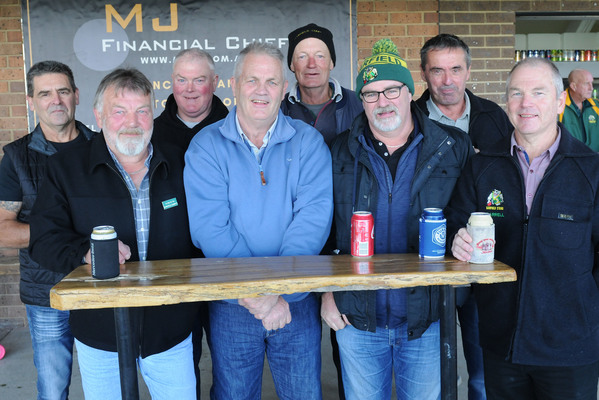
Tom Cleary – Bunyip and Garfield legend, two-time Breheny medallist as the best player in West Gippsland
For decades there Bunyip and Garfield didn’t even play against each other, but Cleary knows the rivalry from both sides.
After starting his career and spending the bulk of his playing days at Bunyip – the club he still calls home – he also played for the combined Garfield, Bunyip and Cora Lynn cricket side, along with his brothers, before he enjoyed a real period of success with the Garfield Football Club for three seasons in the 1980s.
But to this day, he takes pride in the knowledge that he never played against Bunyip – his hometown.
“I played for Garfield for three years, but Bunyip for 20,” he said.
Cleary stayed with Bunyip for one more season after its switch to Ellinbank, and then headed to Garfield in the old West Gippsland.
He raved about just how well run the club was in that period under Joe Lenders and Chris Soumilas.
“I played one year in the EDFL and Joey Lenders got me down to Garfield in 1983,” Cleary explained.
“I was welcomed with open arms – no problem at all. That was fantastic, and we actually happened to win the premiership that year.
“Three of my team mates in that premiership – Glen Murtagh, Peter Hermans, and Glen O’Halloran – all played in Bunyip’s 1990 premiership as a matter of fact, and they were all very, very good players.
“In those days (the 1980s) there was a big difference between the Bunyip footy club and the way Joey Lenders and Chris Soumilas ran the Garfield footy club.
“Success breeds success, and I loved it there at Garfield. I still love going back – my Breheny medals are in the cupboard there, and I’ve always got an affinity with that club.
“I’ve even still got a letter somewhere from when I applied for a clearance to Mulgrave in 1986. I’ve got this magnificent letter from Golly (Chris Soumilas) – he said they wouldn’t possibly stand in the way, and it was just so well-written and it really added a touch of professionalism, the way he and Joey ran that club at the time.”
When Cleary was at Garfield, the storied Bunyip rivalry was out of sight, out of mind – given that they never played against each other, being in separate leagues.
He explained how the rivalry became dormant right up until Garfield’s own move to Ellinbank in 2010.
“They won in 2011 (against Neerim-Neerim South), we won in 2012, and they won in 2013,” he said.
“It’s probably fair the two sides won one each against each other.”
Note that Cleary still refers to Garfield as “they”, and Bunyip as “we”.
“There was a rivalry again in that period – particularly that grand final Bunyip won in 2012,” he said.
“My nephew, Michael Whyte, got the best on ground medal and his direct opponent was Ned Marsh – his best mate.
“I’m taking Michael as an example here because he’s related to me – Zeke Hower, all those boys are all mates of his. They’re all terrific blokes.
“The start of the rivalry goes back before our time. I know I’m of a different generation now, but I don’t believe there was any significant rivalry between Garfield and Bunyip after Bunyip went to the Ellinbank league in 1982. We didn’t play each other for those 28 years.
“Don’t get me wrong though – when Garfield plays Bunyip there’s a fierce competitiveness there. You always want to win.”
But for Cleary – and Greening, Walker, and Barnes alike – what underpins the rivalry is the genuine mateship.

